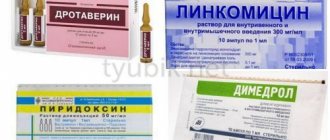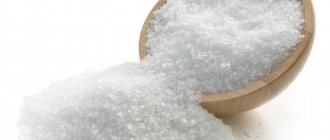Also see the article - table salt
Sodium chloride
or
sodium chloride
(NaCl) - sodium salt of hydrochloric acid. Known in everyday life as table salt, the main component of which is. Sodium chloride is found in significant quantities in sea water. It occurs naturally in the form of the mineral halite (rock salt). Pure sodium chloride appears as colorless crystals, but with various impurities its color can take on a blue, purple, pink, yellow or gray tint.
Saline sodium chloride solution
In the process of creating this pharmacological composition, salts are introduced into distilled water in a certain way. In this case, each subsequent component is added only after the previous one has completely dissolved. In addition, to prevent sediment from forming in the liquid, carbon dioxide is passed through the sodium bicarbonate. Glucose is added to the solution last. Strict adherence to the specified production technology ensures the preservation of all the beneficial properties of sodium chloride. Depending on the percentage of salts, the following types of solutions are distinguished:
- isotonic (9%) – used for preparing injections and droppers.
- hypertensive (10%) – used as an auxiliary osmotic diuretic for various serious pathological conditions.
Pharmacological group
According to the classification of medicinal substances, sodium chloride (Natrii chloridum/Sodium chloride) is usually classified as a regulator of water-electrolyte balance and acid-base balance. Due to the fact that the product is used for diluting and dissolving medications, it also belongs to the group of excipients, reagents and intermediates. In addition, some experts classify isotonic sodium chloride solution as an anticongestant - decongestant drug.
Properties
The drug acts as a detoxifying and rehydrating agent. Sodium chloride (NaCl) is used to enrich the body with fluid and increase the volume of circulating arterial blood. This pharmacological effect of saline solution is determined by the presence in it of mineral ions that have the ability to penetrate the cell membrane through a variety of transport mechanisms. According to the pharmacopoeia, sodium chloride helps maintain constant blood pressure and takes part in the electrophysiological processes of the body.
Indications for use
Water-salt balance directly affects the maintenance of the normal state of all organs and systems of the human body. In a normal situation, the NaCl compound enters the body along with food, which is impossible if any pathologies develop. Thus, with vomiting, diarrhea and other similar conditions, there is an increased release of sodium and chlorine ions from the body. This condition is an absolute indication for intravenous sodium chloride.
In addition, the drug is recommended for external use to wash the eyes, nose, and mouth. Separately, it is worth mentioning the benefits of saline solution for treating purulent wounds. The sodium and chlorine salts contained in the preparation have high antimicrobial activity, which is often used by surgeons to prevent the occurrence of postoperative complications. Among other things, the use of NaCl is justified in the following conditions:
- dyspepsia;
- poisoning;
- cholera;
- constipation;
- extensive burns;
- hyponatremia;
- hypochloremia;
- forced diuresis;
- internal bleeding;
- dehydration.
Description and composition
Chemical substance, crystalline, whitish. There is a saline solution of sodium chloride containing nine grams of the substance per liter of distilled water. There is a hypertonic solution that contains one hundred grams of the substance per liter.
Sodium chloride is available in ampoules of five, ten or twenty milliliters for injections. There are also bottles with a solution of one hundred, two hundred, four hundred and one thousand milliliters. They are administered intravenously.
A ten percent solution is also available in two hundred and four hundred milliliter bottles. There are tablets for oral use and nasal drops.
Instructions for use of sodium chloride
In most cases, saline solution is administered intravenously or subcutaneously. Meanwhile, the use of sodium chloride may involve its entry into the body orally or rectally. As a rule, one or another method of using a drug is determined by the expectation of a certain therapeutic effect. So, in case of severe poisoning, you will agree that it is more logical to use saline solution intravenously than to try to do cleansing enemas.
In general, patients tolerate NaCl well. However, with prolonged use of the drug, overdose effects may be observed: acidosis, extracellular hyperhydration, hypokalemia. In addition, it is important to talk about the specific drug interactions of the solution. Sodium chloride (and its analogs) is compatible with most medications. When diluted with a solution of powdered antibiotics, an increase in their bioavailability is noted. The drug is not recommended to be combined with corticosteroids (Enalapril) and leukopoiesis stimulants (Filgrastim).
For rinsing the nose
Nasal spray based on sodium chloride has a lot of positive properties and almost no side effects. Therefore, sodium chloride for nasal rinsing is used especially widely in pediatric practice to eliminate runny nose in young patients without harm to their health. A saline-based nasal spray is instilled into the nasal passage only after it has been thoroughly cleansed. Adults are recommended to take 2-3 injections three times a day, while for children the indicated dosage should be halved.
- Cookies in a frying pan - recipe with photo. How to make homemade cookies in a frying pan in a hurry
- Hot sandwiches in the oven according to delicious recipes
- Static exercises for weight loss and strength development
Intravenously
In medical practice, parenteral (intravenous) administration of saline is mostly used. For this purpose, the sodium chloride dropper is preheated to 36 degrees. The volume of the administered drug depends on the condition, age and weight of the patient. On average, the daily dose of NaCl should not exceed 500 milliliters. In case of poisoning accompanied by a severe degree of intoxication, the maximum volume can reach 3000 ml. In this case, the rate of infusion (infusion) of the drug is allowed to be increased to 70 drops per minute.
This method of administering saline helps to immediately restore the water-salt balance in the body - this is why sodium chloride is injected intravenously in case of dehydration. In addition, parenteral administration is indicated as plasma replacement therapy and is used for excessively thick blood. It is important to say that saline solution for IVs is often used to dilute any drug that needs to be administered intravenously. In this case, the characteristics of such infusions are determined based on the main medication.
For inhalations
A therapeutic procedure involving inhalation of sodium chloride is indicated for colds. Treatment of infectious pathologies of the respiratory tract is carried out with a combination of saline solution and a bronchodilator. Remember, alkaline (with added salt, soda) inhalations are contraindicated for children under 6 years of age.
Contraindications for sodium chloride
Like any other medicine, NaCl also has some limitations for use. For example, it is prohibited to use saline solution for patients with blood circulation disorders. The fact is that this pathological condition is dangerous due to the development of cerebral edema. For this reason, artificially flooding the body with saline solution during persistent development of circulatory disorders can significantly aggravate the clinical picture of the disease and lead to irreversible consequences. In addition, the use of NaCl is prohibited under the following conditions:
- pulmonary edema;
- hypernatremia;
- hyperchloremia;
- chronic heart failure;
- arterial hypertension;
- acute left ventricular failure;
- during pregnancy and lactation (breastfeeding).
Content
- 1 Occurrence and production 1.1 Halite
- 1.2 Rock salt
- 1.3 Sea salt
- 1.4 Deposits
- 1.5 Production
- 2.1 In the food industry and cooking
Sodium chloride price
In pharmacies in Moscow and St. Petersburg, saline solution can be purchased for an average of 30 rubles. At the same time, some private pharmacies, in an effort to compensate for losses, inflate the price of sodium chloride (often with an expired expiration date). For this reason, most of the population today prefers to buy medicines from bona fide virtual sellers. Meanwhile, you can find out the prices for saline solution for IVs in different pharmacies in Moscow below:
| Pharmacy | Concentration | Volume | Price (rubles) |
| AdonisPharm | 0,9% | Bottle 200 ml | 22 |
| EuroPharm | 0,9% | Bottle 200 ml | 26 |
| ZdravZona | 0,9% №1 | Bottle 100 ml | 23 |
| ZdravZona | 0,9% №10 | Ampoules 5 ml | 24 |
| ZdravZona | 0,9% №12 | 500 ml | 339 |
| ZdravZona | 0.9% Bufus | 5 ml ampoule | 162 |
| ZdravZona | 0.9% B-Brown | 10 ml ampoule | 202 |
| Laboratory of Beauty and Health | 0,9% №35 | 100 ml | 1329 |
| Laboratory of Beauty and Health | 0,9% №20 | 500 ml | 746 |
When is it prescribed?
Saline solution is prescribed in cases of acute water loss.
Typically, such conditions arise due to:
- intoxication;
- vomiting;
- diarrhea;
- infectious diseases;
- burns;
- dehydration.
Sodium chloride is also used for constipation to increase urination. It is also used for internal bleeding. It is also used externally to wash the respiratory tract, eyes, and wounds.
The drug is often prescribed for inhalation for coughs and respiratory diseases. They are also diluted with drugs for intramuscular and intravenous administration.
Overdose
Sometimes, if used incorrectly, an overdose can occur.
Its symptoms:
- nausea;
- vomit;
- diarrhea;
- weakness;
- drowsiness;
- abdominal pain;
- renal failure;
- hypertension;
- convulsions;
- heartbeat;
- elevated temperature;
- increased sodium levels in the blood;
- acidosis.
In case of such phenomena, you should stop using the medicine and treat symptomatically.
Who should not be prescribed
Sodium chloride has contraindications:
- decreased level of potassium in the body;
- pulmonary edema;
- cerebral edema;
- excessive levels of chlorine in the body;
- sodium overdose;
- acute heart failure;
- threat of pulmonary and cerebral edema.
Use the drug with caution in case of high blood pressure, edema, chronic heart failure, chronic renal failure, preeclampsia, and sodium retention in the body.
Side effects
Sometimes unwanted effects occur during treatment.
They look like this:
- acidification of the body;
- excess moisture;
- low potassium levels.
But usually they appear when used incorrectly. Most often, side effects arise from the use of drugs that are diluted with this drug.
If any side effects occur, you should stop taking it and consult a doctor.
Is it possible to rinse your nose or put it in your nose?
Instilling saline into the nose and using it as a rinse is an alternative to expensive medications. If you drip your nose correctly, the effect is noticeable after several procedures. Used for therapeutic purposes by both adults and young children, as well as pregnant and lactating women.
How to use
This medicine is administered subcutaneously and intravenously. The dose is determined depending on the weight and age of the person. The average dose that can be administered during the day is five hundred milliliters. The dropper should be warmed up to 36-37 degrees.
If this is a child, then the dose is calculated as follows: twenty to one hundred milliliters per kilogram of weight.
They also do a rectal enema with a five percent saline solution in a volume of one hundred milliliters in order to induce bowel movements. It can also be administered to eliminate edema, reduce intracranial and blood pressure. Contraindications: inflammation and erosion of the rectum.
The wounds are washed with saline solution as prescribed by the surgeon. Compresses soaked in this medicine are also applied to the wounds. This promotes the drainage of pus and the death of harmful microbes.
The nose is washed with saline solution to treat and prevent sinusitis. Adults take two drops, children – one drop into each nostril. The course of treatment is twenty days.
Saline solution is used for inhalation, adding to the inhaler according to the instructions. You can carry out mixed inhalations by adding ambroxol to saline solution or other mucolytics. Inhalations are carried out up to three times a day for five to ten minutes.
You can prepare your own saline solution at home. To do this, add a teaspoon of salt to a liter of boiled water and stir. But such a solution cannot be used for intravenous administration.








